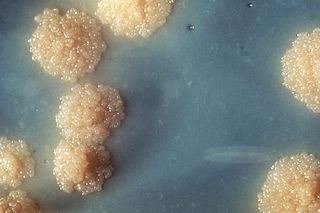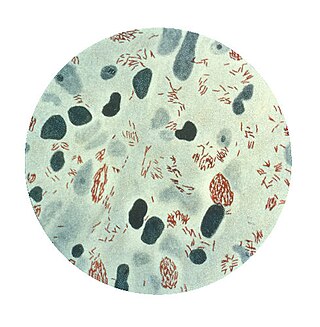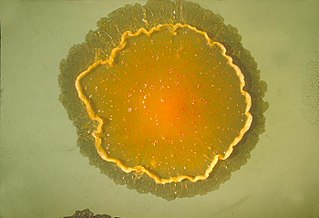
Mycobacterium tuberculosis, also known as Koch's bacillus, is a species of pathogenic bacteria in the family Mycobacteriaceae and the causative agent of tuberculosis. First discovered in 1882 by Robert Koch, M. tuberculosis has an unusual, waxy coating on its cell surface primarily due to the presence of mycolic acid. This coating makes the cells impervious to Gram staining, and as a result, M. tuberculosis can appear weakly Gram-positive. Acid-fast stains such as Ziehl–Neelsen, or fluorescent stains such as auramine are used instead to identify M. tuberculosis with a microscope. The physiology of M. tuberculosis is highly aerobic and requires high levels of oxygen. Primarily a pathogen of the mammalian respiratory system, it infects the lungs. The most frequently used diagnostic methods for tuberculosis are the tuberculin skin test, acid-fast stain, culture, and polymerase chain reaction.

Mycobacterium is a genus of over 190 species in the phylum Actinomycetota, assigned its own family, Mycobacteriaceae. This genus includes pathogens known to cause serious diseases in mammals, including tuberculosis and leprosy in humans. The Greek prefix myco- means 'fungus', alluding to this genus' mold-like colony surfaces. Since this genus has cell walls with Gram-positive and Gram-negative features, acid-fast staining is used to emphasize their resistance to acids, compared to other cell types.

Mycobacterium leprae, is one of the two species of bacteria that cause Hansen’s disease (leprosy), a chronic but curable infectious disease that damages the peripheral nerves and targets the skin, eyes, nose, and muscles.

In cell biology, a phagosome is a vesicle formed around a particle engulfed by a phagocyte via phagocytosis. Professional phagocytes include macrophages, neutrophils, and dendritic cells (DCs).

Clofazimine, sold under the brand name Lamprene, is a medication used together with rifampicin and dapsone to treat leprosy. It is specifically used for multibacillary (MB) leprosy and erythema nodosum leprosum. Evidence is insufficient to support its use in other conditions though a retrospective study found it 95% effective in the treatment of Mycobacterium avium complex (MAC) when administered with a macrolide and ethambutol, as well as the drugs amikacin and clarithromycin. However, in the United States, clofazimine is considered an orphan drug, is unavailable in pharmacies, and its use in the treatment of MAC is overseen by the Food and Drug Administration. It is taken orally.
The Timpe and Runyon classification of nontuberculous mycobacteria based on the rate of growth, production of yellow pigment and whether this pigment was produced in the dark or only after exposure to light.

Mycobacterium marinum is a slow growing mycobacterium (SGM) belonging to the genus Mycobacterium and the phylum Actinobacteria. The strain marinum was first identified by Aronson in 1926 and it is observed as a pathogenic mycobacterium. For example, tuberculosis like infections in fish (mycobacteriosis) and skin lesions in humans.
Mycobacterium africanum is a species of Mycobacterium that is most commonly found in West African countries, where it is estimated to cause up to 40% of pulmonary tuberculosis. The symptoms of infection resemble those of M. tuberculosis.
Mycobacterium botniense is a slowly growing Mycobacterium, which produces a yellow pigment. It was first isolated from a stream of water. M. botniense is most closely related to Mycobacterium xenopi. Etymology: botniense; of Botnia, referring to the Latin name of the province of Finland from which the isolation was made.
Mycobacterium chubuense is a species of the phylum Actinomycetota, belonging to the genus Mycobacterium.
Mycobacterium conceptionense is a non pigmented rapidly growing mycobacterium was first isolated from wound liquid outflow, bone tissue biopsy, and excised skin tissue from a 31-year-old woman who suffered an accidental open right tibia fracture and prolonged stay in a river. Etymology: conceptionense, pertaining to Hôpital de la Conception, the hospital where the first strain was isolated.
Mycobacterium elephantis, a bacterium of the family Mycobacteriaceae, was discovered and isolated from a deceased elephant near India and may be linked to respiratory dysfunction. Organisms in the genus Mycobacterium are known to be aerobic and non-motile. Organisms within Mycobacterium belong to either the rapid growing group or the slow growing group. M. elephantis is classified as a rapid grower and relates most closely to Mycobacterium confluentis and Mycobacterium phlei.
Mycobacterium avium complex is a group of mycobacteria comprising Mycobacterium intracellulare and Mycobacterium avium that are commonly grouped because they infect humans together; this group, in turn, is part of the group of nontuberculous mycobacteria. These bacteria cause Mycobacterium avium-intracellulare infections or Mycobacterium avium complex infections in humans. These bacteria are common and are found in fresh and salt water, in household dust and in soil. MAC bacteria usually cause infection in those who are immunocompromised or those with severe lung disease.

Mycobacterium kansasii is a bacterium in the Mycobacterium genus. It is an environmental bacteria that causes opportunistic infections in humans, and is the one of the leading mycobacterial causes of human disease after tuberculosis and leprosy.
Mycobacterium vaccae is a nonpathogenic species of the Mycobacteriaceae family of bacteria that lives naturally in soil. Its generic name originates from the Latin word, vacca (cow), since the first Mycobacterium strain was cultured from cow dung in Austria. Mycobacterium vaccae was first isolated from the Ugandan Lang'o District, where locals claimed that a "muddy substance had the power to cure a number of ailments". Research areas being pursued with regard to killed Mycobacterium vaccae vaccine include immunotherapy for allergic asthma, cancer, depression, leprosy, psoriasis, dermatitis, eczema and tuberculosis.

In enzymology, a malate synthase (EC 2.3.3.9) is an enzyme that catalyzes the chemical reaction

Mycobacterium ulcerans is a species of bacteria found in various aquatic environments. The bacteria can infect humans and some other animals, causing persistent open wounds called Buruli ulcer. M. ulcerans is closely related to Mycobacterium marinum, from which it evolved around one million years ago, and more distantly to the mycobacteria which cause tuberculosis and leprosy.
Mycolicibacterium agri is a species of bacteria from the phylum Actinomycetota that was first isolated from soil. It is non-pigmented and grows rapidly at 25–45 °C on Ogawa egg medium. It has also been isolated from a human skin infection, and raw milk M. agri is capable of degrading octocrylene.
Mycolicibacterium aichiense is a species of bacteria from the phylum Actinomycetota that was first isolated from soil and from human sputum. It produces pigments when grow in the dark and grows rapidly at 25–37 °C on Ogawa egg medium or Sauton agar medium.








